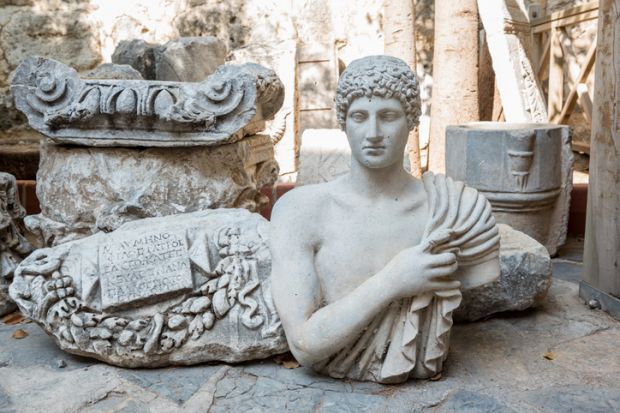These days, passionate defenders of the liberal arts find ourselves in a difficult position. We know our disciplines are in a bad way, yet we serve institutions concerned more about being seen to care about them than to actually makes sacrifices for them by diverting substantial resources and institutional capital their way.
At my own college, I am living amidst one of the most prominent examples of this: Purdue University’s Cornerstone Integrated Liberal Arts Programme.
Concerns about this programme would simply be an intramural issue were it not for the PR blitz and concerted efforts to pitch it to other universities. Cornerstone now educates more than 4,000 students a year, and because Purdue is so large and known for being exceedingly STEM-centric, the higher education world is paying attention.
The National Endowment for the Humanities and the Teagle Foundation have devoted $7 million to launching the programme at other colleges and universities. And recently, Melinda Zook, the programme’s director, published an advice column reporting that Cornerstone is “being replicated at 60 other institutions (and counting)”.
So if you and your institution are enquiring about how to reform liberal arts education, Cornerstone is among the first places you’d look.
In lieu of the standard public speaking and English composition courses, Cornerstone students fulfill their written and oral communication requirements by taking a two-semester sequence of courses in which they write essays and practise public speaking, while engaging with what the programme calls “transformative texts” (loosely equating to the best that has been thought and written, from antiquity to the present). Some stop there, but students wishing to earn a certificate in liberal arts pursue a further three courses in various departments across our college.
The praise has been, at times, breathless. Stephen Mintz contends that “the Cornerstone classroom is a rehearsal space for democracy [where] students find that the boundaries of race, gender and cultural difference can be crossed by exercising the sympathetic imagination”. Leonard Cassuto believes Cornerstone answers the “question of how to bring more undergraduates back to the liberal arts”. In The Washington Post, our own dean laments that liberal arts courses are often “stale, overly dogmatic and uninteresting to students” and offers Cornerstone as “a solution…that not only addresses the void in specialised STEM curricula, but promises to revitalise a stagnant liberal arts curriculum”.
Cornerstone’s goals are certainly worth emulating. But, as I have learned from watching the programme grow and from talking to dozens of colleagues involved in it, the reality of its delivery is quite messy.
The programme is advertised as offering first-year students a seminar-style engagement with tenure-track professors. However, while the cap of 30 students per class may seem relatively low, it precludes intimate discussions around a table. The Conference on College Composition and Communication – the recognised authority on the teaching of writing at the university level – recommends a cap of 20 or, ideally, 15. With double that ideal number, the ability of teachers to offer comments on drafts and final versions of the required three major essays is, to put it charitably, severely hampered.
Moreover, Cornerstone’s claim to be putting students into the classroom with faculty is also problematic. Alongside the ranks of the tenure-track, its faculty list contains a cornucopia of titles that most faculty would struggle to recognise – assistant teaching professors, professors of teaching, and assistant professors of practice among them. I mean no disparagement of these fine, hard-working colleagues; indeed, would that they were offered tenure within the programme. But Cornerstone’s reliance on the precariat suggests that it wants to look like it’s mimicking the classroom experience of a Swarthmore but without devoting the same financial resources.
Compounding this concern, many of those non-tenure-track colleagues teach four sections of students in parallel. That would take up far more than a full 40-hour work week by itself. How can such a schedule offer even the bare minimum of the intellectual development needed to be a good teacher?
Finally, all new tenure-track hires in our college are contractually obliged to teach half their courses in Cornerstone. It is right to insist that faculty, regardless of discipline, should have face time with students from across the university. But colleagues from fields that do not specialise in textual interpretation (such as anthropology and sociology) report feeling completely unqualified and unprepared to teach speaking and writing.
In practice, this requirement has bred resentment, as those joining Purdue now are being asked to devote half of their teaching careers to transformative texts and imparting the skills of writing and public speaking, while senior, pre-Cornerstone colleagues teach in the programme on a strictly volunteer basis – or, more often, not at all.
It doesn’t have to be this way. The liberal arts have always had the potential to thrive, even at a place like Purdue. Zook proclaims: “The days when we could simply lecture in front of the classroom have passed.” But in my experience, the best teachers among us were never doing that. We actively engage our students in the close reading of primary and secondary texts, in justifying their interpretations through essays and discussions, in applying their insights to contemporary problems, and so on.
Cornerstone, as originally conceived, offers one way of manifesting these pedagogical ideals – but only if its founding principles are properly implemented, rather than being used as window dressing for just another higher education numbers game.
The author is a faculty member in the College of Liberal Arts at Purdue University.
Register to continue
Why register?
- Registration is free and only takes a moment
- Once registered, you can read 3 articles a month
- Sign up for our newsletter
Subscribe
Or subscribe for unlimited access to:
- Unlimited access to news, views, insights & reviews
- Digital editions
- Digital access to THE’s university and college rankings analysis
Already registered or a current subscriber? Login








